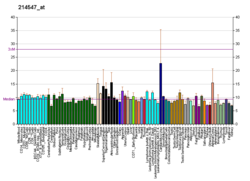| ADCY10 |
|---|
|
| Available structures |
|---|
| PDB | Ortholog search: PDBe RCSB |
|---|
| List of PDB id codes |
|---|
4CLK, 4CLL, 4CLP, 4CLS, 4CLT, 4CLU, 4CLW, 4CLY, 4CLZ, 4CM0, 4CM2, 4OYA, 4OYB, 4OYI, 4OYM, 4OYO, 4OYP, 4OYW, 4OYX, 4OYZ, 4OZ2, 4OZ3, 4UST, 4USU, 4USV, 4USW, 5D0R |
|
|
| Identifiers |
|---|
| Aliases | ADCY10 , HCA2, SAC, SACI, Sacy, hsAC, HEL-S-7a, adenylate cyclase 10 (soluble), adenylate cyclase 10, soluble, adenylate cyclase 10 |
|---|
| External IDs | OMIM: 605205; MGI: 2660854; HomoloGene: 10188; GeneCards: ADCY10; OMA:ADCY10 - orthologs |
|---|
|
|
|
|
|
| Wikidata |
|





